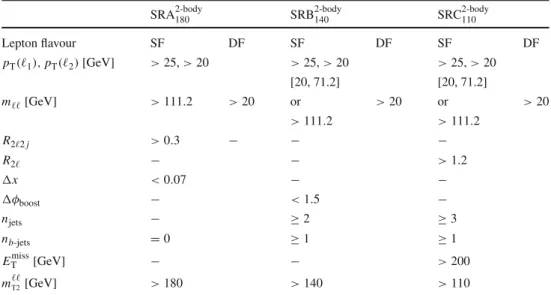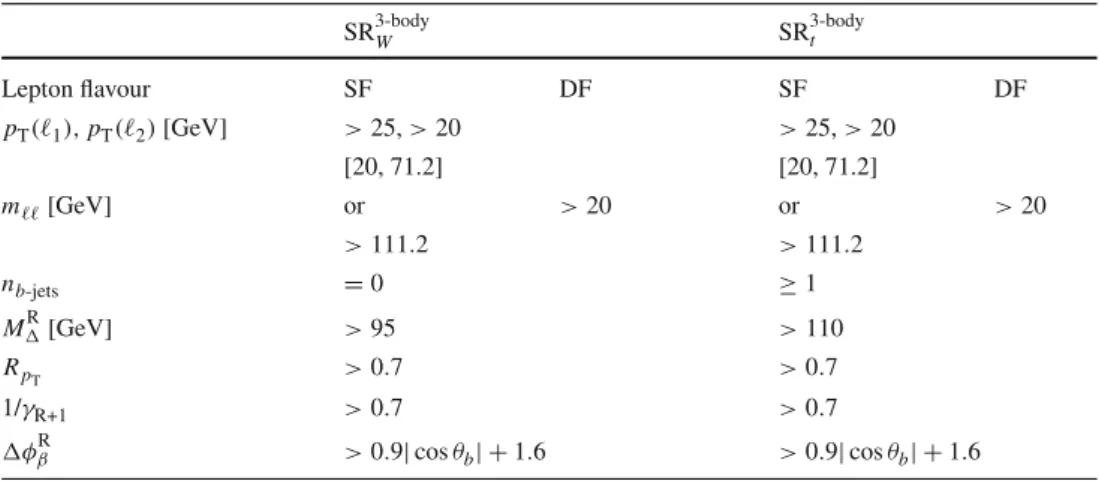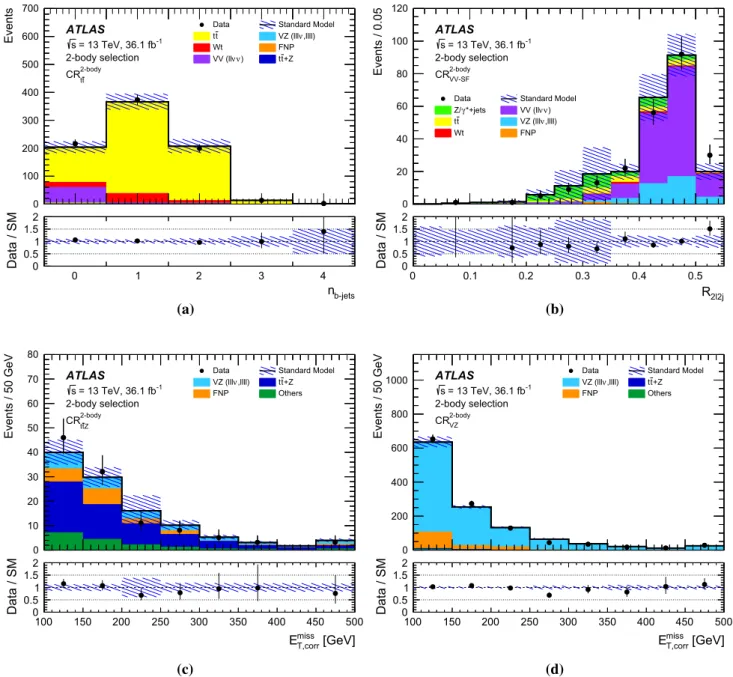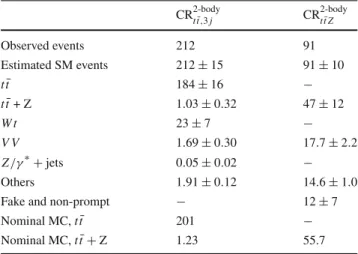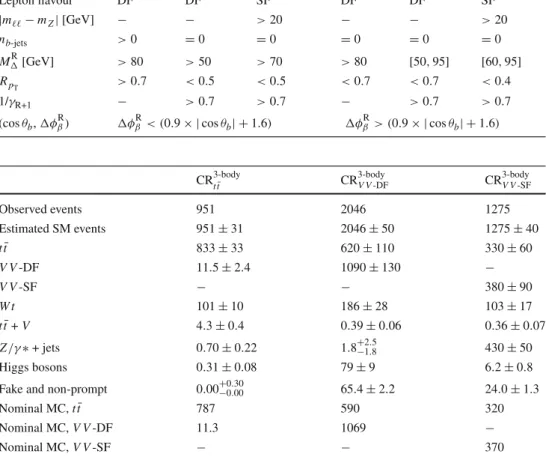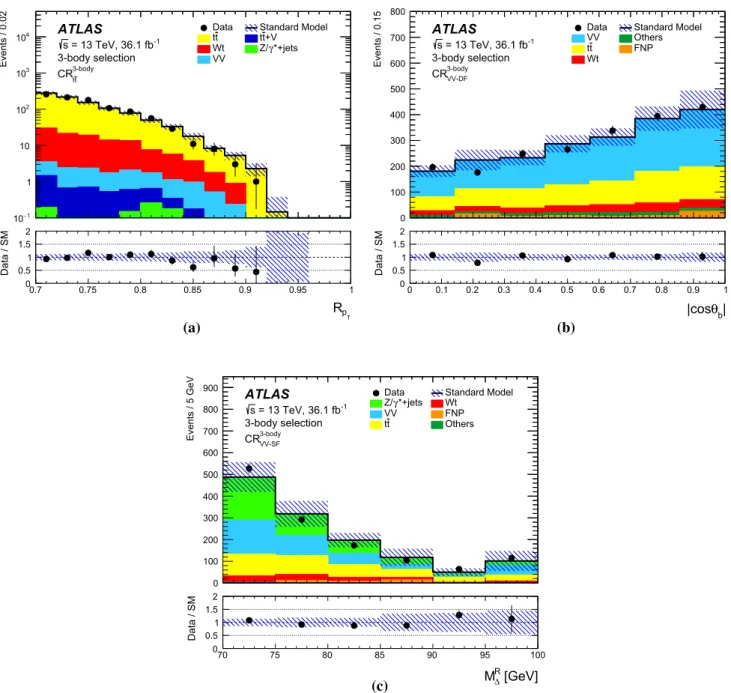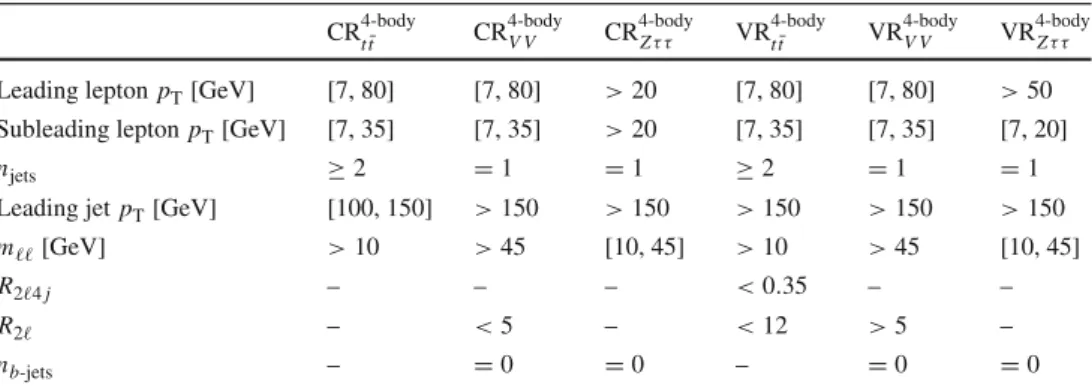https://doi.org/10.1140/epjc/s10052-017-5445-x Regular Article - Experimental Physics
Search for direct top squark pair production in final states with two leptons in √
s = 13 TeV pp collisions with the ATLAS detector
ATLAS Collaboration CERN, 1211 Geneva 23, Switzerland
Received: 11 August 2017 / Accepted: 4 December 2017 / Published online: 22 December 2017
© CERN for the benefit of the ATLAS collaboration 2017. This article is an open access publication
Abstract The results of a search for direct pair production of top squarks in events with two opposite-charge leptons (electrons or muons) are reported, using 36.1 fb−1of inte- grated luminosity from proton–proton collisions at√
s=13 TeV collected by the ATLAS detector at the Large Hadron Collider. To cover a range of mass differences between the top squarkt˜and lighter supersymmetric particles, four possi- ble decay modes of the top squark are targeted with dedicated selections: the decayt˜→bχ˜1±into ab-quark and the light- est chargino withχ˜1± → Wχ˜10, the decayt˜→tχ˜10into an on-shell top quark and the lightest neutralino, the three-body decayt˜ → bWχ˜10 and the four-body decayt˜ → bνχ˜10. No significant excess of events is observed above the Stan- dard Model background for any selection, and limits on top squarks are set as a function of thet˜andχ˜10 masses. The results exclude at 95% confidence levelt˜masses up to about 720 GeV, extending the exclusion region of supersymmetric parameter space covered by previous searches.
1 Introduction
The standard model (SM) of particle physics is extremely successful in describing the phenomena of elementary parti- cles and their interactions. Nevertheless, it is believed to be only a low-energy realisation of a more general theory. In its current form, it fails to explain several observations, such as the nature of dark matter, the baryon asymmetry of the uni- verse and the stabilisation of the Higgs boson mass against radiative corrections from the Planck scale. These shortcom- ings could be remedied by the existence of new particles at the TeV scale, which motivates extensive searches at the Large Hadron Collider (LHC).
One of the most compelling theories beyond the SM is Supersymmetry (SUSY) [1–6]. SUSY is a space-time sym- metry that for each SM particle postulates the existence of a partner particle whose spin (S) differs by one-half unit.
e-mail:atlas.publications@cern.ch
The introduction of gauge-invariant and renormalisable inter- actions into SUSY models can violate the conservation of baryon number (B) and lepton number (L), resulting in a pro- ton lifetime shorter than current experimental limits [7]. This is usually solved by assuming that the multiplicative quan- tum numberR-parity [8], defined asR = (−1)3(B−L)+2S, is conserved.
In the framework of a genericR-parity-conserving model, SUSY particles are produced in pairs, and the lightest super- symmetric particle (LSP) is stable and a candidate for dark matter [9,10]. The scalar partners of right-handed and left- handed quarks (squarks),q˜R andq˜L, can mix to form two mass eigenstates,q˜1andq˜2, withq˜1defined to be the lighter one. In the case of the supersymmetric partner of the top quark, t˜, large mixing effects can lead to one top squark mass eigenstate,t˜1, that is significantly lighter than the other squarks. The charginos and neutralinos are mixtures of the bino, winos and Higgsinos that are superpartners of the U(1) and SU(2) gauge bosons and the Higgs bosons, respectively.
Their mass eigenstates are referred to as χ˜i± (i = 1,2) andχ˜0j (j = 1,2,3,4) in order of increasing masses. In a large variety of models, the LSP is the lightest neutralino
˜ χ10.
In this paper a search for direct pair production of the top squark is reported, in final states with two isolated lep- tons (electrons or muons) and missing transverse momentum.
The search utilises 36.1 fb−1of proton–proton collision data collected by the ATLAS experiment in 2015 and 2016 at a centre-of-mass energy√
s=13 TeV.
The top squark is assumed to decay into either the lightest chargino or the lightest neutralino. Depending on the mass difference between the top squark and the lighter SUSY parti- cles, different decay modes are relevant. The decayst˜→tχ˜10
andt˜→ bχ˜1±(wheret andbrepresent either the quark or the anti-quark, depending on the charge conjugation) with
˜
χ1±→Wχ˜10dominate when they are kinematically accessi- ble. For intermediate mass differences,mχ˜0
1 +mW +mb<
(a) (b)
(c) (d)
Fig. 1 Diagrams representing the four main signals targeted by the analyses:athe decay of the top squark via the lightest chargino (˜t→ bχ˜1±),bthe two-body decay into an on-shell top quark and the lightest neutralino (˜t →tχ˜10),cthe three-body decay mode into an on-shell Wboson, ab-quark and the lightest neutralino (˜t→bWχ˜10) anddthe four-body decay mode (˜t→b f fχ˜10) where the two fermions f and
fare a lepton with its neutrino in this article
mt˜ <mχ˜0
1 +mt, the three-body decayt˜→ bWχ˜10is con- sidered. For smaller mass differences, the four-body decay channelt˜→b f fχ˜10, where f andfare two fermions from theW∗decay, is assumed to occur. In this search,f andfare a lepton and its associated neutrino. For each of these decay modes, shown by the diagrams in Fig.1, a dedicated event selection is performed to optimise the search significance, as detailed in Table1.
The results of the searches are interpreted in simplified models [11–13] as a function of the top squark and lightest neutralino masses. Additionally, results are also interpreted in one phenomenological minimal supersymmetric standard model (pMSSM) [14–17] model including the following decay modes:t˜ → tχ˜10,t˜ → bχ˜1± withχ˜1± → Wχ˜10and
˜
t→tχ˜20, withχ˜20→h/Zχ˜10. Previous ATLAS [18,19] and CMS [20–32] analyses have set exclusion limits at 95% con- fidence level (CL) on the signal scenarios considered here.
When considering simplified models including thet˜→tχ˜10
decay, top squark masses up to about 700 GeV have been excluded for a nearly massless lightest neutralino. For the same assumptions about the lightest neutralino mass, if the t˜→bχ˜1±decay is dominant, top squark masses up to about 500 GeV have been excluded.
2 ATLAS detector
The ATLAS detector [33] at the LHC is a multi-purpose parti- cle detector with a cylindrical forward–backward symmetric geometry1and an approximate 4π coverage in solid angle.
It consists of an inner tracking detector (ID) surrounded by a thin superconducting solenoid providing a 2 T axial magnetic field, electromagnetic and hadron calorimeters, and a muon spectrometer. The inner tracking detector covers the pseudo- rapidity range|η|<2.5. It consists of silicon pixel, silicon microstrip, and transition radiation tracking detectors. The newly installed innermost layer of pixel sensors [34] was operational for the first time during the 2015 data-taking.
Lead/liquid-argon (LAr) sampling calorimeters provide elec- tromagnetic (EM) energy measurements with high granu- larity. A hadron (steel/scintillator-tile) calorimeter covers the central pseudorapidity range (|η| < 1.7). The end-cap and forward regions are instrumented with LAr calorimeters for both the EM and hadronic energy measurements up to
|η| =4.9. The muon spectrometer surrounds the calorime- ters and features three large air-core toroid superconducting magnets with eight coils each. It includes a system of preci- sion tracking chambers and fast detectors for triggering. The field integral of the toroids ranges between 2.0 and 6.0 Tm across most of the detector.
3 Data samples and event reconstruction
The data were collected by the ATLAS detector in 2015 and 2016 during pp collisions at a centre-of-mass energy of √
s = 13 TeV, with a peak instantaneous luminosity of L = 1.4×1034 cm−2s−1, a bunch spacing of 25 ns, and an average number of pp interactions per bunch crossing (pile-up) ofμ =14 in 2015 andμ = 24 in 2016. Only events taken in stable beam conditions, and for which all rele- vant detector systems were operational, are considered in this analysis. The integrated luminosity of the resulting data set is 36.1 fb−1, with an uncertainty of±3.2%. This uncertainty is derived, following a methodology similar to that detailed in Ref. [35], from a preliminary calibration of the luminosity scale usingx–ybeam-separation scans performed in August 2015 and May 2016.
1 ATLAS uses a right-handed coordinate system with its origin at the nominal interaction point (IP) in the centre of the detector and thez-axis along the beam pipe. Thex-axis points from the IP to the centre of the LHC ring, and they-axis points upwards. Cylindrical coordinates(r, φ) are used in the transverse plane,φbeing the azimuthal angle around the z-axis. The pseudorapidity is defined in terms of the polar angleθasη=
−ln tan(θ/2). Rapidity is defined asy=0.5 ln E+pz
/ E−pz whereEdenotes the energy andpzis the component of the momentum along the beam direction.
Table 1 Summary of the sections dedicated to the two-body, three-body and four-body selections and signal types targeted by each selection
Two-body Three-body Four-body
Variables Section4.1
Event selection Section4.2 Section4.3 Section4.4
Background determination Section6.1 Section6.2 Section6.3
Results Section8.1 Section8.2 Section8.3
Interpretation Section8.4
Targeted decay modes bχ˜1±andtχ˜10 bWχ˜10 bνχ˜10
Signal diagram Figure1a, b Figure1c Figure1d
Targetedmt˜range >mb+mχ˜±
1 ≥mb+mW+mχ˜0
1 <mb+mW+mχ˜0 1
or>mt+mχ˜0
1 and<mt+mχ˜0 1
Candidate events are required to have a reconstructed vertex with at least two associated tracks with transverse momentum pT > 400 MeV. The vertex with the highest scalar sum of the squared transverse momenta of the associ- ated tracks is considered the primary vertex of the event.
Electron (baseline) candidates are reconstructed from three-dimensional electromagnetic calorimeter energy depo- sitions matched to ID tracks, and are required to have pseu- dorapidity |η| < 2.47, pT > 7 GeV, and to pass a loose likelihood-based identification requirement [36]. The like- lihood input variables include measurements of calorimeter shower shapes and of track properties from the ID.
Muon (baseline) candidates are reconstructed in the pseu- dorapidity region|η|<2.4 from muon spectrometer tracks matching ID tracks. They must have pT > 7 GeV and must pass the medium identification requirements defined in Ref. [37], which are based on requirements on the number of hits in the different ID and muon spectrometer subsys- tems, and on the significance of the charge-to-momentum ratio (q/p) measurement [37].
Jets are reconstructed from three-dimensional energy clus- ters in the calorimeter [38] with the anti-kt jet clustering algorithm [39,40] with a radius parameter R = 0.4. Only jet candidates with pT >20 GeV and|η|<2.8 are consid- ered. Jets are calibrated as described in Refs. [41,42], and the expected average energy contribution from pile-up clusters is subtracted according to the jet area [43]. Additional selec- tions are applied to jets with pT <60 GeV and|η| < 2.4 in order to reject jets produced in pile-up collisions [44].
The “medium” working point is used for the pile-up rejec- tion, which has an efficiency of about 92% for jets produced by the hard scatter. Jets resulting from the hadronisation of b-quarks are identified using a multivariateb-tagging algo- rithm (MV2c10), which is based on quantities such as impact parameters of associated tracks and reconstructed secondary vertices [45,46]. This algorithm is used at a working point that provides 77%b-tagging efficiency in simulatedtt¯events, and a rejection factor of 134 for light-quark flavours and glu-
ons and 6 for charm jets. The jets satisfying theb-tagging requirements are referred to asb-jets.
Events are discarded if they contain any jet with pT >
20 GeV failing to satisfy basic quality selection criteria that reject detector noise and non-collision backgrounds [47].
To resolve reconstruction ambiguities, an overlap removal algorithm is applied to candidate leptons and jets. Non-b- tagged jets which lie withinR=
(y)2+(φ)2<0.2 (hereystands for the rapidity) from an electron candidate are removed, and the same is done for jets which lie close to a muon candidate and are consistent with the characteristics of jets produced by muon bremsstrahlung. Finally, any lepton candidate which lies withinR<0.4 from the direction of a surviving jet candidate is removed, in order to reject leptons from the decay of ab- orc-hadron. Electrons which share an ID track with a muon candidate are also removed.
Additional selections are then applied to the remaining lepton and jet candidates. Tighter requirements on the lepton candidates are imposed, which are then referred to as “signal”
electrons or muons. Signal electrons must satisfy themedium likelihood-based identification requirement as defined in Ref. [36]. Signal electrons must have a transverse impact parameter with respect to the reconstructed primary vertex, d0, with a significance of|d0|/σ(d0) <5. For signal muons, the corresponding requirement is|d0|/σ(d0) <3. The tracks associated with the signal leptons must have a longitudinal impact parameter with respect to the reconstructed primary vertex,z0, satisfying|z0sinθ| <0.5 mm. Isolation criteria are applied to both electrons and muons by placing an upper limit on the sum of the transverse energy of the calorimeter energy clusters in a cone ofRη=
(η)2+(φ)2=0.2 around the electron (excluding the deposit from the electron itself), and the scalar sum of thepTof tracks within a variable- size cone around the lepton (excluding its own track). The track isolation cone radius for electrons (muons) is given by the smaller ofR=10 GeV/pTandRη=0.2(0.3). The isolation criteria are optimised such that the isolation selec- tion efficiency is uniform across η, and it increases from
95% forpT=25 GeV to 99% for pT=60 GeV inZ → events.
Jets are required to have|η|<2.5.
The missing transverse momentum (pmissT ), whose magni- tude is denoted byEmissT , is defined as the negative vector sum of the transverse momenta of all identified baseline objects (electrons, muons, jets) and an additional soft term. The soft term is constructed from all tracks that are not associated with any reconstructed electron, muon or jet, but which are asso- ciated with the primary vertex. In this way, theETmissvalue is adjusted for the best calibration of the jets and the other iden- tified objects above, while maintaining pile-up independence in the soft term [48,49].
4 Event selection
For the two-body and three-body selections, events are accepted if they pass an online selection (trigger) requiring a minimum of two electrons, two muons or an electron and a muon matched to the trigger objects. The offline selec- tion requires that the leading lepton has a pT larger than 25 GeV and the subleading lepton apTlarger than 20 GeV, ensuring that trigger efficiencies are constant in the relevant phase space. The four-body selection accepts events pass- ing an ETmiss-based trigger and having offline ETmiss >200 GeV. This ensures that the trigger efficiency is constant in the relevant phase space. Using this trigger permits the use of a reduced leptonpTthreshold of 7 GeV, increasing acceptance for the low leptonpTproduced in the four-bodyt˜→bνχ˜10
decay.
Events are required to have exactly two signal leptons which must be of opposite charge (electrons, muons, or one of each) with an invariant mass (regardless of the flavour of the leptons in the pair)mgreater than 20 GeV (10 GeV for the four-body selection) in order to remove leptons from low- mass resonances. Except for the four-body selection, events with same-flavour (SF) lepton pairs withmbetween 71.2 and 111.2 GeV are rejected, in order to reduce the back- grounds with leptons produced byZ bosons. No additional selection is applied to themvalue of different-flavour (DF) lepton pairs. In the following, the requirements described in the preceding part of this section are referred to as “common selection”.
4.1 Discriminators and kinematic variables
For the different decay modes considered, dedicated sets of discriminating variables are used to separate the signal from the SM backgrounds.
The missing transverse momentum and thepTof the lead- ing leptons and jets are used to define three useful ratio vari- ables:
R22j =EmissT /(ETmiss+pT(1)+pT(2) +pT(j1)+pT(j2)),
R2 =EmissT /(pT(1)+pT(2)), and
R24j =ETmiss/(ETmiss+pT(1)+pT(2)+
i=1,...,N≤4 pT(ji)),
wherepT(1)andpT(2)are the leading and subleading lep- ton transverse momenta and pT(ji=1,...,N≤4)are the trans- verse momenta in decreasing order of up to the four leading jets. The variables R22j and R2 are used to reject back- grounds, e.g.Z/γ∗+jets, which peak at lower values than the signal. Similarly,R24jis a powerful discriminant against multi-jet events.
Other variables employed are:
– pT,boost: defined as the vector pT,boost=pmissT +pT(1)+pT(2).
The pT,boost variable, with magnitude pT,boost, can be interpreted as the opposite of the vector sum of all the transverse hadronic activity in the event.
– φboost: the azimuthal angle between the pmissT vector and thepT,boostvector.
– x: defined as x= 2·
pz(1)+pz(2) ECM
where ECM = 13 TeV is used and pz(1),pz(2)are respectively the leading and subleading lepton longitudi- nal momenta. This variable helps to discriminate between gluon- and quark-initiated processes. The former tend to peak towards zero, while the latter tend to peak at higher values.
– cosθb: the cosine of the angle between the direction of motion of either of the two leptons and the beam axis in the centre-of-mass frame of the two leptons [50]. This variable is sensitive to the spin of the pair-produced parti- cle, providing additional rejection against diboson back- grounds.
– mT2: lepton-based “stransverse” mass. The stransverse mass defined in Refs. [51,52] is a kinematic variable used to bound the masses of a pair of identical particles which have each decayed into a visible and an invisible particle.
This quantity is defined as mT2(pT,1,pT,2,qT)
= min qT,1+qT,2=qT
max[mT(pT,1,qT,1),mT(pT,2,qT,2)] ,
wheremT indicates the transverse mass,2pT,1andpT,2 are the transverse momentum vectors of two particles, andqT,1andqT,2are transverse momentum vectors with qT =qT,1+qT,2. The minimisation is performed over all the possible decompositions of qT. For tt¯or W W decays witht →bνandW →ν, when the transverse momenta of the two leptons in each event are taken aspT,1 and pT,2, and pmissT as qT, mT2(pT(1),pT(2),pmissT ) is bounded sharply from above by the mass of the W boson [53,54]. In thet˜→ bχ˜1±decay mode the upper bound is strongly correlated with the mass difference between the chargino and the lightest neutralino. In this paper, mT2(pT(1),pT(2),pmissT )is referred to simply asmT2.
The three-body selection uses a number of “super-razor”
variables that are defined in Ref. [55]. They are designed to identify events with two massive parent particles (i.e. top squarks) each decaying into a set of visible (only leptons are considered in this case, all other particles including jets are ignored) and invisible particles (i.e. neutrinos and neutrali- nos). These variables are:
– RpT: defined as
RpT = | JT|
| JT| +√ ˆ sR/4,
whereJTis the vector sum of the transverse momenta of the visible particles and the missing transverse momen- tum, and
ˆ
sRis a measure of the system’s energy in the razor frame R as defined in Ref. [55] as the frame in which the two visible leptons have equal and opposite pz. In the case where all possible visible particles are considered, the razor frame R becomes an approxima- tion of the pair production centre-of-mass frame with the centre-of-mass energy√
ˆ
sR. In this analysis, only lep- tons are considered in the visible system. Therefore,Rp
T
tends towards zero in events that do not contain additional activity (i.e. dibosons) due to vanishing| JT|, whereas in events that contain additional activity (i.e.tt¯) this vari- able tends towards unity, thus providing separation power between the two cases.
– γR+1: The Lorentz factor associated with the boosts from the razor frameRto the approximations of the two decay frames of the parent particles. It is a measure of how the two visible systems are distributed, tending towards unity when the visible particles are back-to-back or have
2The transverse mass is defined by the equation mT(pT,qT) = 2|pT||qT|(1−cos(φ)), whereφis the angle between the particles of negligible mass with transverse momentap andq .
different momenta, while preferring lower values when they are equal in momenta and collinear.
– MR: defined as
MR = sˆR γR+1
.
This variable has a kinematic end-point that is propor- tional to the mass-splitting between the parent particle and the invisible particle. Therefore, it provides rejection against both the top quark and diboson production pro- cesses when it is required to be greater than the mass of theW boson, and in this case it also helps to reject the residualZ/γ∗+jets background.
– φβR: The quantityφβRis the azimuthal angle between the razor boost from the laboratory to the Rframe and the sum of the visible momenta as evaluated in the R frame. For systems where the invisible particle has a mass that is comparable to the pair-produced massive particle, this variable has a pronounced peak nearπ, making it, in general, a good discriminator in searches for models with small mass differences.
4.2 Two-body event selection
This selection targets the top squark two-body decays (Fig.1a, b) into either a bottom quark and a chargino, with the chargino decaying into the lightest neutralino and aW boson, or a near-mass-shell top quark and a neutralino.
In these decays, the kinematic properties of signal events are similar to those oftt¯events. In particular, when the top squarks are produced at rest the momenta carried by the neu- tralinos in the final state are small and the discrimination difficult. Better separation between signal events and thett¯ background can be obtained for top squark pairs which recoil from initial-state radiation (ISR).
Three signal regions (SRs), summarised in Table2 and denoted by SR(A,B,C)2x−body, wherexstands for the lower bound of themT2 interval, were optimised to target different scenarios:
• SRA2-body180 targets the decays intobχ˜1±in scenarios where mt˜
1 −mχ˜±
1 is below 10 GeV and the b-jets from the decay of thet˜1are too low in energy to be reconstructed.
For this reason,b-jets with pT >25 GeV are vetoed to reduce the contamination from SM processes including top quarks. No further requirement is imposed on the hadronic activity of the event. Events with SF leptons are required to havem >111.2 GeV and R22j >0.3 to reduce the contamination fromZ/γ∗+jets events. The contribution from diboson production is expected to be the dominant background in the SR and it is reduced by
Table 2 Two-body selection
signal region definitions SRA2-body180 SRB2-body140 SRC2-body110
Lepton flavour SF DF SF DF SF DF
pT(1),pT(2)[GeV] >25,>20 >25,>20 >25,>20
[20, 71.2] [20, 71.2]
m[GeV] >111.2 >20 or >20 or >20
>111.2 >111.2
R22j >0.3 − − −
R2 − − >1.2
x <0.07 − −
φboost − <1.5 −
njets − ≥2 ≥3
nb-jets =0 ≥1 ≥1
ETmiss[GeV] − − >200
mT2[GeV] >180 >140 >110
requiring the events to have x < 0.07. Furthermore, events are required to havemT2 >180 GeV.
• SRB2-body140 targets the decays intobχ˜1±in scenarios with a mass-splitting between the top squark and the chargino larger than 10 GeV, such that the jets from the hadroni- sation ofb-quarks are expected to be detectable. At least two jets with pT >25 GeV are required, with at least one of them being identified as ab-jet. Events fromtt¯ andZ/γ∗+jets production are suppressed by requiring φboost<1.5. The main expected SM processes satisfy- ing this selection arett¯andtt+Z¯ with theZboson decay- ing into neutrinos. A final selection ofmT2 >140 GeV is applied. Because of the similar final state, this selection is the most sensitive to signal scenarios in which thet˜1 decays intot+ ˜χ10, with largemt˜1−mχ˜0
1.
• SRC2-body110 targets the decays intot + ˜χ10, in scenarios wheremt˜
1 ∼mχ˜0
1 +mt. Candidate events are required to have ETmiss > 200 GeV and at least three jets with pT > 25 GeV, where one of the jets is interpreted as ISR. The other two jets are expected to arise from the decay of the top quarks in the final state. One of the jets in the event is required to beb-tagged, effectively separating the signal events from SM diboson production.
TheZ/γ∗+jets background is suppressed by requiring R2 to be larger than 1.2. Events are finally required to havemT2 >110 GeV.
For the model-dependent exclusion limits, a shape fit of the mT2 distribution is performed for the SRA2-body180 and SRB2-body140 selections: the distribution is divided into bins of width 20 GeV, starting frommT2 =120 GeV; the last bin’s low boundary corresponds to the requirement on the same variable in the definitions of SRA2-body180 and SRB2-body140 ; each
bin is referred to as SR(A,B)2x−,ybody, wherexandydenote the low and high edges of the bin.
4.3 Three-body event selection
This selection targets the top squark three-body decay mode (Fig.1c), which is expected to be the dominant decay mode when the two-body decay mode into the lightest chargino or neutralino is kinematically forbidden, i.e. formχ˜0
1 +mW +
mb<mt˜
1 <mχ˜0
1 +mtandmt˜
1 <mχ˜± 1 +mb.
Two orthogonal signal regions, SR3-bodyW and SR3-bodyt , are summarised in Table3. The SR3-bodyW targets the region where m(˜t,χ˜10) ∼ mW in which the producedb-jets have low transverse momentum, and hence are often not reconstructed.
The second signal region SR3-bodyt targets the region in which m(t,˜ χ˜10)∼mt.
The two regions make use of a common set of require- ments on RpT, γR+1, and in the two-dimensional (cosθb, φβR) plane. In addition, SR3-bodyW requires that no b-jet is identified in the event and that MR > 95 GeV. The large MRrequirement suppresses the top quark and diboson back- grounds. In the case of SR3-bodyt , the requirements are: at least oneb-jet andMR>110 GeV. Theb-jet requirement makes the selection orthogonal to SR3-bodyW , so that the two SRs can be statistically combined. Furthermore, a slightly tighter MR requirement is necessary to eliminate the background that originates from top quark production processes.
4.4 Four-body event selection
The selection described here targets the four-body decay mode of the top squark (Fig.1d) for scenarios wheremt˜
1 <
Table 3 Three-body selection
signal region definitions SR3-bodyW SR3-bodyt
Lepton flavour SF DF SF DF
pT(1),pT(2)[GeV] >25,>20 >25,>20
[20, 71.2] [20, 71.2]
m[GeV] or >20 or >20
>111.2 >111.2
nb-jets =0 ≥1
MR[GeV] >95 >110
Rp
T >0.7 >0.7
1/γR+1 >0.7 >0.7
φβR >0.9|cosθb| +1.6 >0.9|cosθb| +1.6
mχ˜0
1+mb+mW andmt˜
1 <mχ˜±
1 +mb. In this region the top squark decay intocχ˜10might be dominant, depending on var- ious SUSY model parameters. The branching ratio into this final state is here assumed to be negligible. For these small mass splittings, the leptons in the final state, originating from the virtualW boson decays, are expected to have lowpT.
Signal events can be distinguished from SM processes if a high-pTjet from ISR leads to a large transverse boost of the sparticle pair system and enhances theETmissvalue. At least two jets with pT > 25 GeV are required in the event. The leading jet is considered to be the ISR jet and required to have pT >150 GeV. Since the jets resulting fromt˜decays tend to have lowpTin this scenario, at most one more energetic jet with pT > 25 GeV is permitted in the event and the transverse momentum of the third jet (if present) must satisfy pT(j3)/ETmiss<0.14.
In order to remove events originating from low-mass reso- nances, the invariant mass of the two leptons,m, is required to be greater than 10 GeV. Furthermore, upper limits on pT(1)andpT(2), respectively of 80 GeV and 35 GeV, are applied.
The signal region SR4−bodyis defined as summarised in Table4. The two variablesR24jandR2must be larger than 0.35 and 12 to reject multi-jet andtt¯backgrounds, respec- tively. Finally, the two most energetic jets in the event must not be tagged asb-jets.
5 Samples of simulated events
Monte Carlo (MC) simulated event samples are used to aid in the estimation of the background from SM processes and to model the SUSY signal. The event generator, parton shower and hadronisation generator, cross-section normali- sation, parton distribution function (PDF) set and underlying- event parameter set (tune) of these samples are given in Table5, and more details of the event generator configura-
Table 4 Four-body selectionsignal region definition SR4−body
Lepton flavour SF and DF
ETmiss[GeV] >200
pT(1)[GeV] [7, 80]
pT(2)[GeV] [7, 35]
m[GeV] >10
njets ≥2
pT(j1)[GeV] >150
pT(j2)[GeV] >25
pT(j3)/ETmiss <0.14
R24j >0.35
R2 >12
nb-jets veto onj1andj2
tions can be found in Refs. [56–59]. Cross-sections calculated at next-to-next-to-leading order (NNLO) in QCD including resummation of next-to-next-to-leading logarithmic (NNLL) soft gluon terms were used for top quark production pro- cesses. For production of top quark pairs in association with vector or Higgs bosons, cross-sections calculated at next- to-leading order (NLO) were used, and the event generator cross-sections calculated bySherpa (at NLO for most of the processes) are used when normalising the multi-boson backgrounds. In all MC samples, except those produced bySherpa, theEvtGenv1.2.0 program [60] was used to model the properties of the bottom and charm hadron decays.
Additional MC samples are used when estimating systematic uncertainties, as detailed in Sect.7.
SUSY signal samples were generated from leading-order (LO) matrix elements with up to two extra partons, using the MadGraph5_aMC@NLO [61] event generator. The two-body signals usedPythia8.186 [62] for the modelling of the SUSY decay chain, parton showering, hadronisation and the description of the underlying event. The three-body
Table5Simulatedsignalandbackgroundeventsamples:thecorrespondingeventgenerator,partonshowergenerator,cross-sectionnormalisation,PDFsetandunderlying-eventtuneareshown PhysicsprocessEventgeneratorPartonshowergeneratorCross-sectionnormalisationPDFsetTune SUSYSignalsMadGraph5_aMC@NLO2.2.3[61]Pythia8.186[62]NLO+NLL[63–68]NNPDF23LO[69]A14[70] Z/γ∗ +jetsSherpa2.2.1[71]Sherpa2.2.1NNLO[72]NLOCT10[69]Sherpadefault t¯tpowheg-boxv2[73]Pythia6.428[74]NNLO+NNLL[75–80]NLOCT10Perugia2012[81] Wtpowheg-boxv2Pythia6.428NNLO+NNLL[82]NLOCT10Perugia2012 t¯tW/Z/γ∗ MadGraph5_aMC@NLO2.2.2Pythia8.186NLO[61]NNPDF23LOA14 DibosonSherpa2.2.1Sherpa2.2.1GeneratorNLONLOCT10Sherpadefault t¯thMadGraph5_aMC@NLO2.2.2Herwig2.7.1[83]NLO[84]CTEQ6L1[85]A14 Wh,ZhMadGraph5_aMC@NLO2.2.2Pythia8.186NLO[84]NNPDF23LOA14 t¯tWW,t¯tt¯tMadGraph5_aMC@NLO2.2.2Pythia8.186NLO[61]NNPDF23LOA14 tZ,tWZ,t¯ttMadGraph5_aMC@NLO2.2.2Pythia8.186LONNPDF23LOA14 TribosonSherpa2.2.1Sherpa2.2.1GeneratorLO,NLOCT10Sherpadefault
and four-body signals were decayed withPythia8 +Mad- Spin[86] instead. Parton luminosities were provided by the NNPDF23LO PDF set. Jet–parton matching was realised following the CKKW-L prescription [87], with a match- ing scale set to one quarter of the pair-produced super- partner mass. In all cases, the mass of the top quark was fixed at 172.5 GeV. Signal cross-sections were calculated to next-to-leading order in the strong coupling constant, adding the resummation of soft gluon emission at next-to- leading-logarithmic accuracy (NLO + NLL) [67,88,89]. The nominal cross-sections and their uncertainties were taken from an envelope of cross-section predictions using differ- ent PDF sets and factorisation and renormalisation scales, as described in Ref. [68]. All two-, three- and four-body sam- ples were generated assuming a 100% branching ratio into the respective final states.
For the pMSSM inspired models, the mass spectrum of sparticles was calculated using Softsusy 3.7.3 [90] and cross-checked with SPheno 3.3.8 [91,92] and Suspect 2.5 [93].HdecayandSdecay, included inSusy- Hit[94]
were used to generate decay tables of the SUSY particles.
To simulate the effects of additionalppcollisions in the same and nearby bunch crossings, additional interactions were generated using the soft QCD processes of Pythia 8.186 with the A2 tune [95] and the MSTW2008LO PDF set [96], and they were overlaid onto each simulated hard- scatter event. The MC samples were reweighted to the pile- up distribution observed in the data. The MC samples were processed through an ATLAS detector simulation [97] based onGeant4 [98] or, in the case of ttt¯ and the SUSY sig- nal samples, a fast simulation using a parameterisation of the calorimeter response andGeant4for the other parts of the detector [99]. All MC samples are reconstructed in the same manner as the data. Corrections derived from data con- trol samples are applied to simulated events to account for differences between data and simulation in reconstruction efficiencies, momentum scale and resolution of leptons and in the efficiency and false positive rate for identifying jets resulting from the hadronisation ofb-quarks.
6 Background estimation
The dominant SM background processes satisfying the SR requirements are estimated by simulation, which is nor- malised to data and verified in separate regions of the phase space. Dedicated control regions (CRs), described in Sects. 6.1–6.3, enhanced in a particular background com- ponent are used for the normalisation. Subdominant back- ground yields are taken directly from MC simulation or from additional independent studies in data. For each signal region, a simultaneous “background fit” is performed to the num- ber of events found in the CRs, using a statistical minimi-
sation based on a likelihood implemented in the HistFitter package [100]. In each fit, the normalisations of the back- ground contributions having dedicated CRs are allowed to float, while the MC simulation is used to describe the shape of distributions of kinematical variables. The level of agree- ment between the background prediction and data is com- pared in dedicated validation regions (VRs), which are not used to constrain the background normalisation or nuisance parameters in the fit.
In order to keep the background control region kinemati- cally as close as possible to the SR, the two-body, three-body and four-body selections use different sets of CRs. The defi- nitions of the regions used in each analysis and the results of the fits are described in the following subsections.
The background due to jets misidentified as leptons (here- after referred to as “fake” leptons) and non-prompt leptons is collectively referred to as “FNP”: it consists of semilep- tonic tt,¯ s-channel and t-channel single-top-quark, W + jets and light- and heavy-flavour multi-jet events. It is esti- mated from data with a method similar to that described in Refs. [101,102]. Two types of lepton identification criteria are defined for this evaluation: “tight” and “loose”, corre- sponding to signal and baseline leptons described in Sect.3.
The method makes use of the number of observed events containing loose–loose, loose–tight, tight–loose and tight–
tight lepton pairs in a given SR. The probability for prompt leptons satisfying the loose selection criteria to also pass the tight selection is measured using a Z → ( = e, μ) sample. The equivalent probability for fake or non-prompt leptons is measured in data from multi-jet- andtt¯-enriched control samples. The number of events containing a contribu- tion from one or two fake or non-prompt leptons is calculated from these probabilities.
Systematic uncertainties in the samples of simulated events affect the expected yields in the different regions and are taken into account to determine the uncertainties in the background predictions. The systematic uncertainties are described by nuisance parameters, which are not constrained by the fit, since the number of floating background normali- sation parameters is equal to the number of CRs. Each uncer- tainty source is described by a single nuisance parameter, and all correlations between background processes and selections are taken into account. A list of systematic uncertainties con- sidered in the fits is provided in Sect.7.
6.1 Two-body selection background determination
The main background sources for the two-body selec- tion are respectively diboson production in SRA2-body180 and tt¯ and tt¯ + Z in SRB2-body140 and SRC2-body110 . These pro- cesses are normalised to data in dedicated CRs, sum- marised in Table 6 together with the corresponding VRs:


